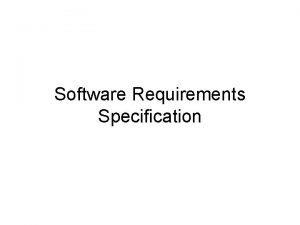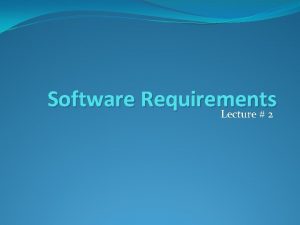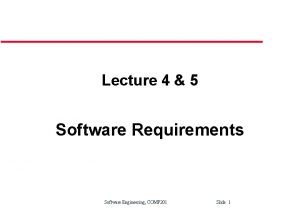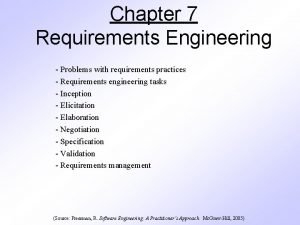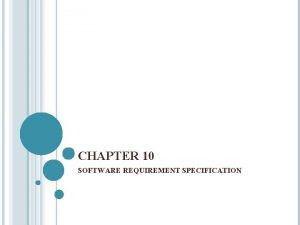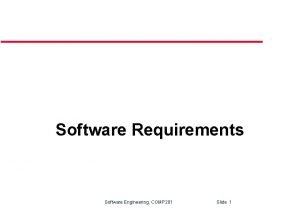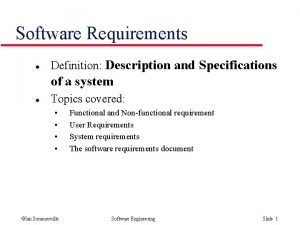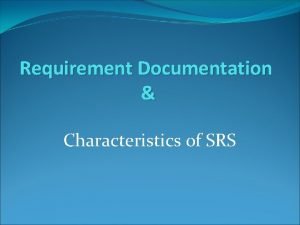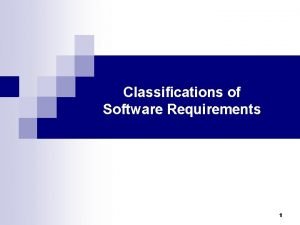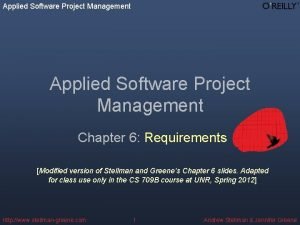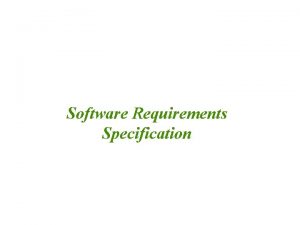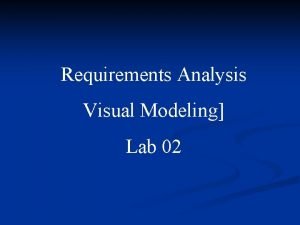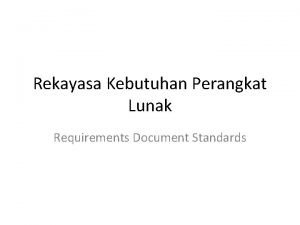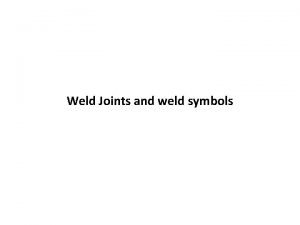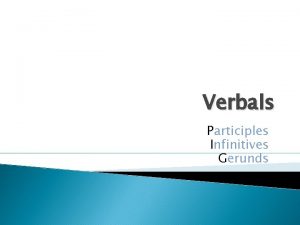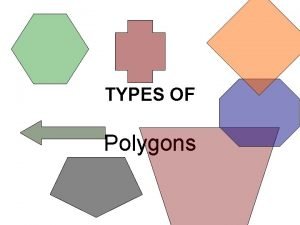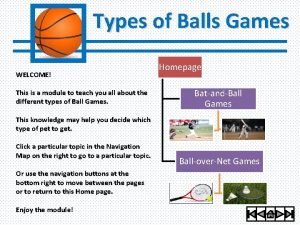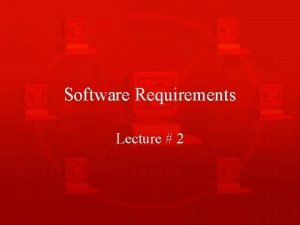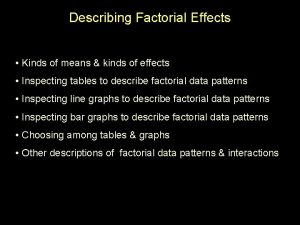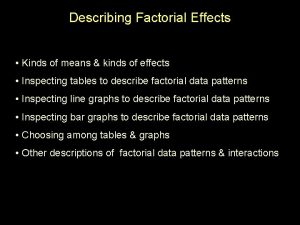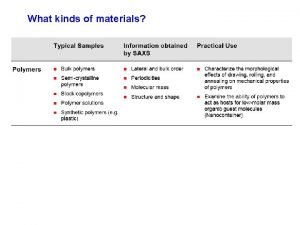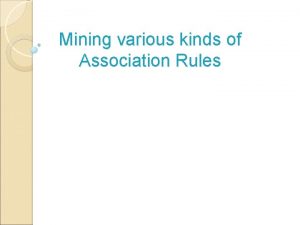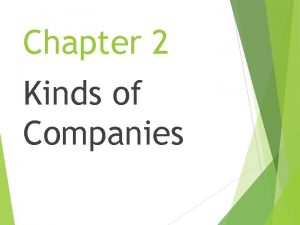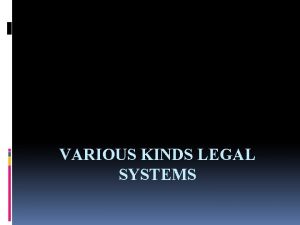Software Requirements Lecture 2 Kinds of Software Requirements











































- Slides: 43

Software Requirements Lecture # 2

Kinds of Software Requirements �Functional requirements �Non-functional requirements �Domain requirements �Inverse requirements �Design and implementation constraints 2

Non-Functional Requirements

Non-Functional Requirements - 1 �Most non-functional requirements relate to the system as a whole. They include constraints on timing, performance, reliability, security, maintainability, accuracy, the development process, standards, etc. 4

Non-Functional Requirements - 2 �They are often more critical than individual functional requirements �Capture the emergent behavior of the system, that is they relate to system as a whole 5

Non-Functional Requirements - 3 �Must be built into the framework of the software product �Failure to meet a non-functional system requirement may make the whole system unusable 6

Non-Functional Requirements - 4 �For example, if an aircraft system does not meet reliability requirements, it will not be certified as ‘safe’ �If a real-time control system fails to meet its performance requirements, the control functions will not operate correctly 7

Non-Functional Requirements Non-Functional requirements Product requirements Organizational requirements External requirements 8

Product Requirements Product requirements Usability requirements Performance requirements Efficiency requirements Reliability requirements Portability requirements Space requirements 9

Product Requirements Examples �The system shall allow one hundred thousand hits per minute on the website �The system shall not have down time of more than one second for continuous execution of one thousand hours 10

Organizational Requirements Organizational requirements Standards requirements Implementation requirements Delivery requirements 11

Organizational Requirements Examples �The system development process and deliverable documents shall conform to the MIL-STD-2167 A �Any development work sub-contracted by the development organization shall be carried out in accordance with Capability Maturity Model 12

External Requirements External requirements Interoperability requirements Ethical requirements Privacy requirements Legislative requirements Safety requirements 13

External Requirements Examples �The system shall not disclose any personal information about members of the library system to other members except system administrators �The system shall comply with the local and national laws regarding the use of software tools 14

Summary �Discussed different aspects of the nonfunctional requirements �Non-functional requirements capture very important emergent behavior of the automated system �Due importance, time, and resources should be given to non-functional requirements 15

References �‘Requirements Engineering: Processes and Techniques’ by G. Kotonya and I. Sommerville, John Wiley & Sons, 1998 �Software Requirements: Objects, Functions, and States by A. Davis, PH, 1993 �Software Engineering 6 th Edition, by I. Sommerville, 2000 �Software Engineering 5 th Edition, by R. Pressman 16

Kinds of Software Requirements �Functional requirements �Non-functional requirements �Domain requirements �Inverse requirements �Design and implementation constraints 17

Non-Functional Requirements Discussion �NFRs are very important to capture the emergent behavior of the system in these there major dimensions �Product �Usability, reliability, portability, efficiency (performance, space) �Organizational �Standards, implementation, delivery �External �Interoperability, ethical, legislative (privacy, safety) 18

NFRs as Goals �Non-functional requirements are sometimes written as general goals, which are difficult to verify �They should be expressed quantitatively using metrics (measures) that can be objectively tested 19

Example: Goal converted into an NFR �Goal (unverifiable) �The system should be easy to use by experienced controllers and should be organized in such a way that user errors are minimized �Non-functional requirement (verifiable) �Experienced controllers shall be able to use all the system functions after a total of two hours’ training. After this training, the average number of errors made by experienced users shall not exceed two per day 20

Metrics for Non-Functional Requirements (NFRs)

Metrics for NFRs - 1 Property Measure 1. Speed 2. 3. Processed transactions/second Response time Screen refresh time Requirements related to “Speed” can use different measures to quantify the goal 22

Metrics for NFRs - 2 Property Size Measure 1. 2. K bytes Number of function points 23

Metrics for NFRs - 3 Property Ease of use Measure 1. 2. Training time Number of help frames 24

Metrics for NFRs - 4 Property Reliability Measure 1. 2. 3. 4. Mean time to failure Probability of unavailability Rate of failure occurrence Availability 25

Metrics for NFRs - 5 Property Robustness Measure 1. 2. 3. Time to restart after failure Percentage of events causing failure Probability of data corruption on failure 26

Metrics for NFRs - 6 Property Portability Measure 1. 2. Percentage of targetdependent statements Number of target systems 27

Discussion on Metrics for NFRs �With the help of these measures the NFRs can be verified quantitatively �It should also be noted that the cost of quantitatively verifying each NFR may be very high 28

Kinds of Software Requirements �Functional requirements �Non-functional requirements �Domain requirements �Inverse requirements �Design and implementation constraints 29

Domain Requirements

Domain Requirements - 1 �Requirements that come from the application domain and reflect fundamental characteristics of that application domain �These can be both the functional or non-functional requirements 31

Domain Requirements - 2 �These requirements, sometimes, are not explicitly mentioned �Domain experts find it difficult to convey domain requirements �Their absence can cause significant dissatisfaction 32

Domain Requirements – 3 �Example: In a commission-based sales businesses, there is no concept of negative commission. However, if care is not taken novice developers can be lured into developing systems, which calculate negative commission 33

Domain Requirements - 4 �Banking domain has its own specific constraints, for example, most banks do not allow over-draw on most accounts, however, most banks allow some accounts to be over-drawn 34

Kinds of Software Requirements �Functional requirements �Non-functional requirements �Domain requirements �Inverse requirements �Design and implementation constraints 35

Inverse Requirements

Inverse Requirements - 1 �They explain what the system shall not do. Many people find it convenient to describe their needs in this manner �These requirements indicate the indecisive nature of customers about certain aspects of a new software product 37

Inverse Requirements - 2 �Example: The system shall not use red color in the user interface, whenever it is asking for inputs from the end-user 38

Kinds of Software Requirements �Functional requirements �Non-functional requirements �Domain requirements �Inverse requirements �Design and implementation constraints 39

Design and Implementation Constraints - 1 �They are development guidelines within which the designer must work �These requirements can seriously limit design and implementation options �Can also have impact on human resources 40

Design and Implementation Constraints Examples �The system shall be developed using the Microsoft. Net platform �The system shall be developed using open source tools and shall run on Linux operating system 41

Summary �Discussed different kinds of requirements including domain, inverse, and implementation constraints �Requirements should be explored from different perspectives and categorized differently 42

References �‘Requirements Engineering: Processes and Techniques’ by G. Kotonya and I. Sommerville, John Wiley & Sons, 1998 �Software Requirements: Objects, Functions, and States by A. Davis, PH, 1993 �Software Engineering 6 th Edition, by I. Sommerville, 2000 �Software Engineering 5 th Edition, by R. Pressman 43
 01:640:244 lecture notes - lecture 15: plat, idah, farad
01:640:244 lecture notes - lecture 15: plat, idah, farad Software engineering lecture notes
Software engineering lecture notes Project management lecture notes doc
Project management lecture notes doc Lecture presentation software
Lecture presentation software Requirement specification
Requirement specification Domain requirements
Domain requirements Inverse requirements
Inverse requirements What is domain requirements in software engineering
What is domain requirements in software engineering Requirements discovery techniques in software engineering
Requirements discovery techniques in software engineering System requirements document
System requirements document What is domain requirements
What is domain requirements User requirements
User requirements Inception elicitation elaboration negotiation
Inception elicitation elaboration negotiation Requirement specification adalah
Requirement specification adalah Comp
Comp Form-based specifications
Form-based specifications Modifiability in srs is
Modifiability in srs is Persyaratan spesifikasi perangkat
Persyaratan spesifikasi perangkat Source and sink analysis in software engineering
Source and sink analysis in software engineering Software requirements types
Software requirements types Applied software project management
Applied software project management Ieee srs
Ieee srs Visual models for software requirements
Visual models for software requirements Ieee830 テンプレート
Ieee830 テンプレート Kinds of wounds with pictures
Kinds of wounds with pictures Forms of love
Forms of love Kinds of engineering
Kinds of engineering Difference between text and discourse
Difference between text and discourse Fictional character
Fictional character Welding symbol
Welding symbol Types of verbals
Types of verbals List of verbals
List of verbals Gerund participles and infinitives
Gerund participles and infinitives Simple horticultural societies
Simple horticultural societies Pentagons
Pentagons Headline sample
Headline sample Claim of fact examples
Claim of fact examples The types of characters
The types of characters Kinds of balls
Kinds of balls Kinds of character in a story
Kinds of character in a story Exclamatory sentence
Exclamatory sentence Kinds of sentences
Kinds of sentences What is love tank
What is love tank Philip sidney defence of poesy
Philip sidney defence of poesy




